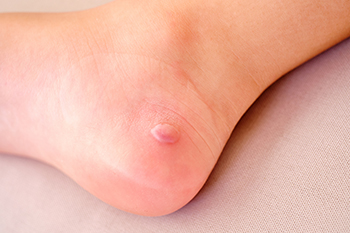
Foot blisters are typically caused by friction from shoes or prolonged pressure on the skin. They can also develop from excessive sweating or irritation due to wearing tight-fitting footwear. While most blisters heal on their own, an infection can occur if bacteria enter the broken skin. An infected foot blister may become red, swollen, and increasingly painful. Pus may begin to drain from the blister, and the area around it may feel warm to the touch. In some cases, fever and a general sense of illness may develop, indicating the infection has spread. If the blister becomes larger or if the pain intensifies, it is essential to seek medical attention to prevent further complications. Keeping the area clean and avoiding further irritation can help reduce the risk of infection. If you have developed a foot blister that has become infected, it is suggested that you promptly consult a chiropodist who can offer relief and treatment remedies.
Blisters can usually be treated at home, however, if you have recurring blisters or experience significant discomfort or pain, please consult with one of the chiropodists from Complete Family Footcare & Therapy. Our clinicians will assess your condition and provide you with quality foot and ankle treatment.
What Is a Blister?
A blister is a small pocket of fluid in the upper skin layers and is one of the body’s natural responses to injury or pressure. Blisters can also result from burns, fungal or viral skin infections, and the feet are particularly prone due to ill-fitting footwear and friction. Friction on the skin causes the upper layer of skin to separate from the lower layers. The space that this separation creates then becomes filled with a liquid called serum, which protects the lower layers of skin.
Treatment
If you notice a blister on your foot, you can cover it with a soft bandage or dressing to protect it. Popping the blister is discouraged. Doing so exposes the raw skin underneath it to bacteria and also raises the risk of infection. If a blister pops naturally, let it drain before covering it with a bandage. Blisters usually heal on their own or with home treatment, however, if your blister is recurring, very painful, or appears infected, it is recommended that you see a chiropodist for treatment.
Prevention
You can help to prevent blisters by wearing comfortable, well-fitted shoes. Keep your feet dry by wearing moisture-wicking socks and dust your feet with talcum powder if they tend to get sweaty. If you have areas on your feet that are more susceptible to blisters, you might be able to prevent the blister from forming by covering it with a pad.
If you have any questions, please feel free to contact our offices located in . We offer the newest diagnostic and treatment technologies for all your foot care needs.
